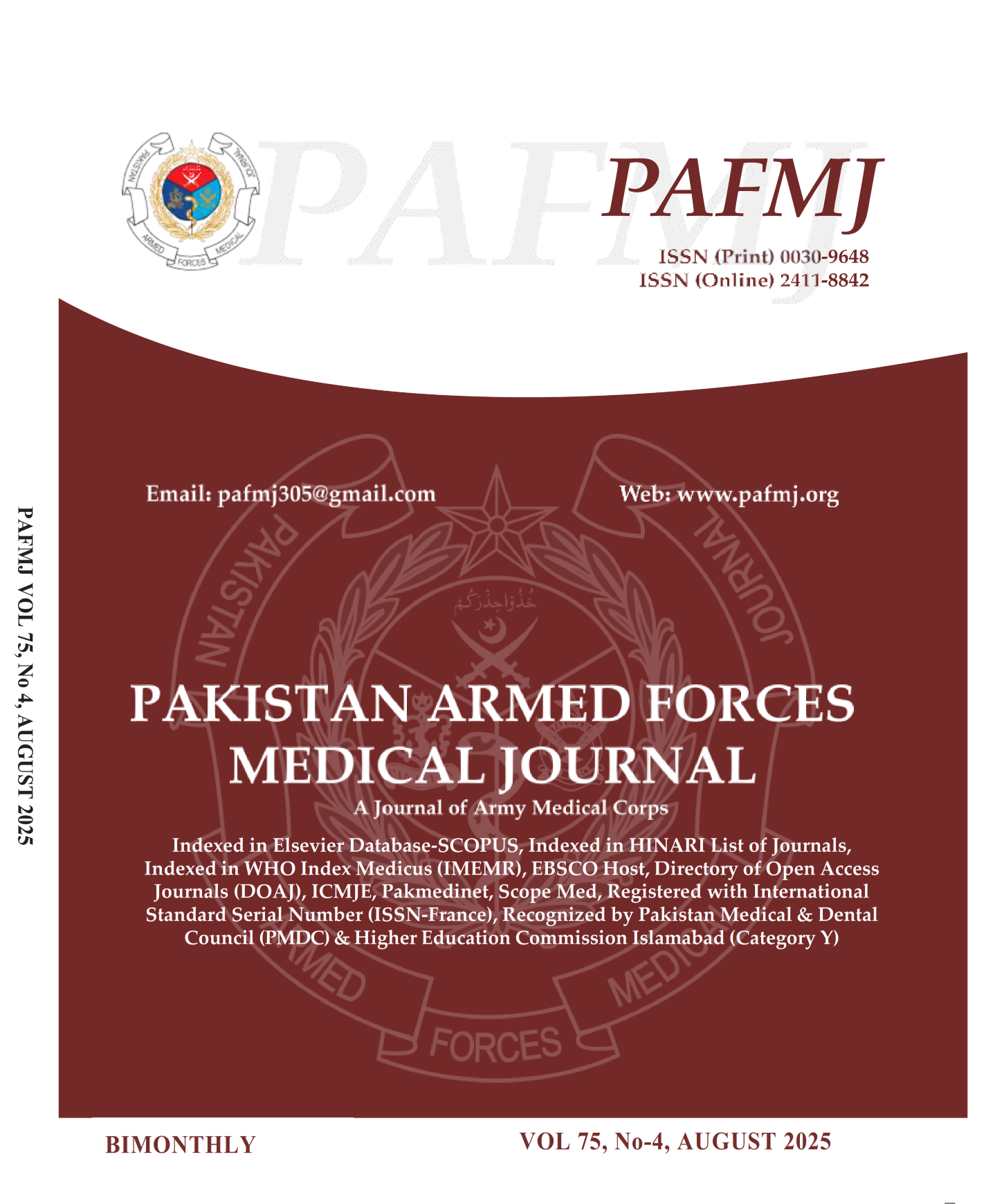Comparison of Pretreatment with Dexmedetomidine and Metoprolol on Attenuation of Hemodynamic Parameters and Emergence During Electroconvulsive Therapy
DOI:
https://doi.org/10.51253/pafmj.v75i4.10399Keywords:
Agitation, Attenuation, Dexmedetomidine, MetoprololAbstract
Objective: To evaluate the effects of Dexmedetomidine and Metoprolol as a pretreatment regimen on hemodynamic parameters and emergence during ECT.
Study Design: Randomized controlled trial (ANZCTR Trial Id: ACTRN12623000539639)
Place and Duration of Study: Department of Anesthesia, CMH, Sialkot, Pakistan, from January 2021 to April 2022.
Methodology: All patients undergoing ECT at CMH were enrolled in this prospective study using a convenient sampling method and divided into three groups. The C Group included subjects not pretreated with any medication. Group-D received an injection of Dexmedetomidine 0.5 μg/kg diluted in 10 mL NaCl, infused intravenously over 10 minutes. Group-M received an injection of Metoprolol 1 mg diluted in 10 mL NaCl, infused over 2 minutes during preoxygenation. Heart rate (HR), systolic blood pressure (SBP), and diastolic blood pressure (DBP) were recorded at baseline, then documented after drug administration at various time intervals
Results: This study performed statistical comparisons of heart rate, blood pressure, and post-procedure recovery parameters among three groups (Group-C, Group-D, and Group-M). Significant differences were found in heart rate, with Group-D and Group-M displaying significantly lower heart rates than Group-C at various time points after the intervention (p<0.001). Additionally, Group-D had significantly higher systolic blood pressure than both Group-C and Group-M after the intervention (p<0.001). Conversely, Group-M showed significantly lower diastolic blood pressure compared to Group-C and Group-D (p<0.05).
Conclusion: Metoprolol at a dose of 1 mg or Dexmedetomidine administered intravenously at a dose of 0.5 µg/kg are both effective methods for attenuating hemodynamic parameters during ECT. .....
Downloads
References
1. Depression and Other Common Mental Disorders: Global Health Estimates. Geneva: World Health Organization; 2017. Licence: CC BY-NC-SA 3.0 IGO.
2. Perera TD, Luber B, Nobler MS, Prudic J, Anderson C, Sackeim HA. Seizure expression during electroconvulsive therapy: relationships with clinical outcome and cognitive side effects. Neuropsychopharmacology 2004; 29(4): 813-825.
http://doi.org/10.1038/sj.npp.1300377
3. Gasteiger L, Heil M, Hörner E, Andexer J, Kemmler G, Hausmann A, et al. Relationship Between Anesthesia Depth and Quality of Seizures in Patients Undergoing Electroconvulsive Therapy: A Prospective Observational Study. J ECT 2022; 38(1): 62-67. https://doi:10.1097/YCT.0000000000000792.
4. West N, Görges M, Poznikoff A, Whyte S, Malherbe S. Association of dexmedetomidine with recovery room and hospital discharge times: A retrospective cohort analysis. Paediatr Anaesth 2021; 31(11): 1170-1178.
https://doi:10.1111/pan.14257.
5. Soehle M, Bochem J. Anesthesia for electroconvulsive therapy. Curr Opin Anaesthesiol 2018; 31(5): 501-505.
https://doi:10.1097/ACO.0000000000000624.
6. Kumar R, Saxena P, Singh A. Randomized control trial to evaluate the role of Dexmedetomidine premedication & ketamine- propofol combination for attenuation of post ECT depression and agitation. J Evol Med Dent Sci 2019; 8(16): 1301-1306.
http://dx.doi.org/10.14260/jemds/2019/290
7. Begec Z, Toprak HI, Demirbilek S, Erdil F, Onal D, Ersoy MO. Dexmedetomidine blunts acute hyperdynamic responses to electroconvulsive therapy without altering seizure duration. Acta Anaesthesiol Scand 2008; 52(2): 302-306.
https://doi:10.1111/j.1399-6576.2007.01462.x.
8. Nazemroaya B, Honarmand A, Bab HA. Effects of adding Dexmedetomidine to ketamine on heart rate and blood pressure changs in psychiatric patients undergoing electroconvulsive therapy. Koomesh 2020; 22(2): 311-316.
https://doi:10.29252/koomesh.22.2.311
9. Qiu Z, Zhou S, Zhang M, Guo N, Huang P, Xiang P, et al. Preventive effect of dexmedetomidine on postictal delirium after electroconvulsive therapy: A randomised controlled study. Eur J Anaesthesiol 2020; 37(1): 5-13. https://doi:10.1097/EJA.0000000000001113.
10. Subsoontorn P, Lekprasert V, Waleeprakhon P, Ittasakul P, Laopuangsak A, Limpoon S. Premedication with dexmedetomidine for prevention of hyperdynamic response after electroconvulsive therapy: a cross-over, randomized controlled trial. BMC Psychiatry 2021;21(1): 408. https://doi:10.1186/s12888-021-03406-9.
11. Modh DB, Parmar MP, Solanki S. Outcome of pretreatment regimens on hemodynamic parameters and emergence during electroconvulsive therapy –a study on dexmedetomidine and esmolol. Anaesth pain & intensive care 2019; 23(1): 52-58
12. Parikh DA, Garg SN, Dalvi NP, Surana PP, Sannakki D, Tendolkar BA. Outcome of four pretreatment regimes on hemodynamics during electroconvulsive therapy: A double-blind randomized controlled crossover trial. Ann Card Anaesth 2017; 20(1): 93-99. https://doi:10.4103/0971-9784.197844.
13. Singh D, Jagannath S, Priye S, Mudassar AS. The comparison of dexmedetomidine, esmolol, and combination of dexmedetomidine with esmolol for attenuation of sympathomimetic response to laryngoscopy and intubation in patients undergoing coronary artery bypass grafting. Ann Card Anaesth 2019; 22(4): 353-357. https://doi:10.4103/aca.ACA_112_18.
14. Fu W, White PF. Dexmedetomidine failed to block the acute hyperdynamic response to electroconvulsive therapy. Anesthesiology 1999; 90(2): 422-424.
https://doi:10.1097/00000542-199902000-00015.
15. Mizrak A, Koruk S, Ganidagli S, Bulut M, Oner U. Premedication with dexmedetomidine and midazolam attenuates agitation after electroconvulsive therapy. J Anesth 2009; 23(1): 6-10. https://doi:10.1007/s00540-008-0695-2.
16. Moshiri E, Modir H, Bagheri N, Mohammadbeigi A, Jamilian H, Eshrati B,et al. Premedication effect of dexmedetomidine and alfentanil on seizure time, recovery duration, and hemodynamic responses in electroconvulsive therapy. Ann Card Anaesth 2016; 19(2): 263-268. https://doi:10.4103/0971-9784.179618.
17. Tamman A, Anand A, Mathew SJ. A comparison of the safety, feasibility, and tolerability of ECT and ketamine for treatment-resistant depression. Expert Opin Drug Saf 2022; 21(6): 745-759. https://doi:10.1080/14740338.2022.2049754.
18. Thörnblom E, Gingnell M, Cunningham JL, Landén M, Bodén R. Intercorrelation of physiological seizure parameters and hormonal changes in electroconvulsive therapy. Nord J Psychiatry 2023; 77(3): 312-318. https://doi:10.1080/08039488.2022.2107237.
Downloads
Published
Issue
Section
License
Copyright (c) 2025 Khalid Mahmood, Mohsin Saleem, Muhammad Ali Abbas, Bilal Yasin, Muhammad Saeed, Saleha Sarfraz

This work is licensed under a Creative Commons Attribution-NonCommercial 4.0 International License.















